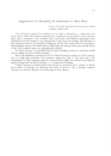Suggestions for Breeding for Resistance to Rice Blast
Tropical agriculture research series : proceedings of a symposium on tropical agriculture researches
| ISSN | 03889386 |
|---|---|
| NII recode ID (NCID) | AA00870529 |

Full text
tars21-_179-179.pdf119.42 KB
True resistance (qualitative resistance) to rice blast is affected by a single gene with major effect, while field resistance (quantitative resistance) is controlled by several multiple genes and/or polygenes. True resistance deals specifically with different pathogenic races and breaks down by changes of the pathogenicity of the races. Accordingly, the utilization of this resistance alone in rice breeding is dangerous. On the other hand, with a few exceptions, field resistance seems to be stable and not affected by the changes of the race and the effects of the field resistance genes are predominantly additive.
For these reasons, it is concluded that the basic breeding strategy for resistance should aim at raising the level of field resistance.
One of the methods to increase the level of field resistance in paddy rice is the introduction of a high field resistance from Japanese upland rice (Fig. 1). The other one is the accumulation of field resistance genes in crosses between paddy rice varieties with different genetic backgrounds in field resistance, i. e. transgression breeding.
If field resistance is incorporated with special true resistance into a variety, it will be more stable. A procedure for selecting these lines is shown in Fig. 2. Besides, multiline varieties can provide adequate protection against blast disease.
For these reasons, it is concluded that the basic breeding strategy for resistance should aim at raising the level of field resistance.
One of the methods to increase the level of field resistance in paddy rice is the introduction of a high field resistance from Japanese upland rice (Fig. 1). The other one is the accumulation of field resistance genes in crosses between paddy rice varieties with different genetic backgrounds in field resistance, i. e. transgression breeding.
If field resistance is incorporated with special true resistance into a variety, it will be more stable. A procedure for selecting these lines is shown in Fig. 2. Besides, multiline varieties can provide adequate protection against blast disease.
| Date of issued | |
|---|---|
| Creator | Tadaaki HIGASHI |
| Publisher | Japan International Research Center for Agricultural Sciences |
| Volume | 21 |
| spage | 179 |
| epage | 179 |
| Language | eng |
